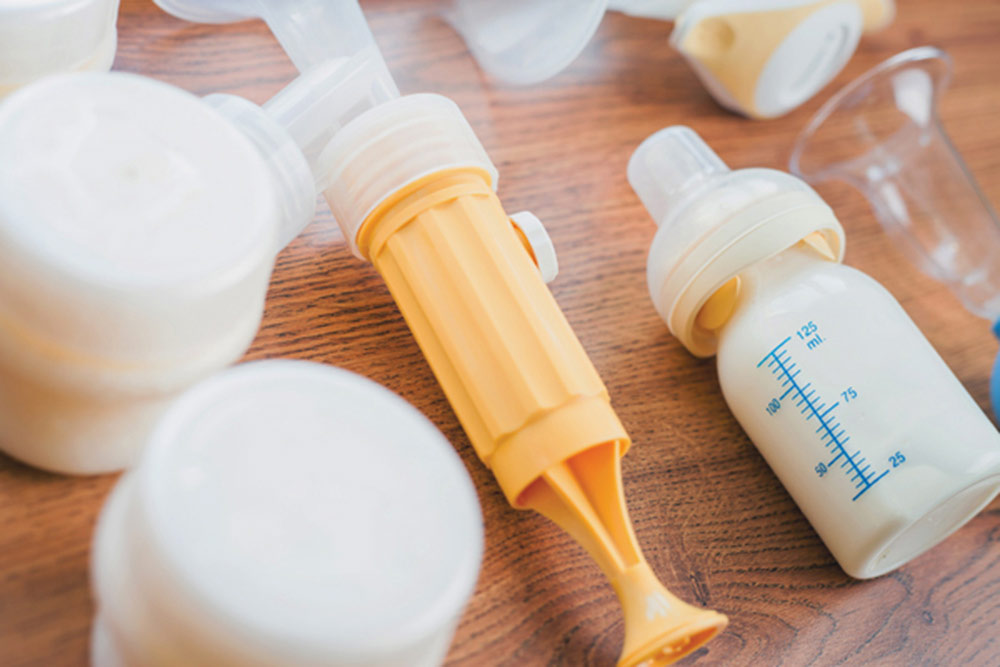Your Plan for Pumping at Work

I'm heading back to work and planning to pump. How can I set myself up for success?
Gina Ciagne, CLC, former vice president of global relations at Lansinoh, knows more than a thing or two about the benefits of breast milk and the perks of pumping when you’re separated from baby during the workday. Read on for her step-by-step guide to mastering the merge of professionalism and everyday mom-duties, making it a win-win-win: for you, your baby and your employer.
Ask co-workers about their experiences.
Every breastfeeding mother has a story about what worked (or didn’t) for her when she returned to work. If you know other working moms who have pumped at the office, talk to them about their trials, errors and solutions to any challenges they may have had. Try not to feel weird about broaching the subject, either. From worrying over milk supply issues to sharing the best ice packs for travel to spilling the beans on achieving a good letdown, there’s plenty to bond over as nursing moms and work friends.
Know the facts support nursing moms.
Hopefully you won’t run into any obstacles with your employer, but if you do, arming yourself with information can help you make a convincing argument to gain support. A study published by the United States Breastfeeding Committee found:
- Lactation programs are cost-effective, showing a $3:1 return on investment. (For every dollar an employer puts toward supporting breastfeeding, a cost savings of $3 is realized.)
- One-day absences to care for sick children occur more than twice as often for mothers of formula-fed infants.
- Breastfeeding lowers insurance claims for businesses. One study showed that for every 1,000 babies not breastfed, there were more than 2,000 extra physician visits, 212 extra hospitalization days and 609 extra prescriptions to treat just three common childhood illnesses.
Meet with your employer.
It’s important to explain your need to have regularly scheduled pumping sessions to your boss. When you do, remember that the protections from the Affordable Care Act are on your side! This health care law under the Fair Labor Standards Act (FLSA) stipulates that an employer must provide a private space (other than a restroom) and reasonable break time for moms to express breast milk.
You can also make an appointment with Human Resources (if applicable) to understand your company’s policies when it comes to pumping breaks, what applies to full-time and part-time employees, how it could affect pay, etc.
For details and an explanation of your rights as a nursing mother, visit the U.S. Department of Labor’s website to review federal laws.
Create a pumping schedule.
Structure your schedule to replicate your baby’s nursing times, so your body gets the necessary signals to continue producing enough milk. Avoid skipping sessions, which can signal your body to produce less milk.
If remembering to step away from the task at hand is difficult, try setting alarms on your phone or use an app that helps track pumping sessions and your output amount.
Find a private place and get set up.
It’s important to pump without disruption, so the necessary hormones are released for letdown. Having a lactation room at work is ideal, but other options include a private office or storage room that can lock and has access to an electrical outlet for electric pumps. (It’s worth investing in a hands-free pumping bra as well, so you can easily look at pictures of baby on your phone or just feel more relaxed.) Always avoid using the bathroom, even in a pinch—it’s not sanitary.
Be flexible, but don’t neglect your breasts.
Consider your employer’s expectations as well as baby’s needs. Even if you have only a few minutes, pump anyway (if at all possible) to avoid skipping a session. Regular stimulation is more important for your body’s response to maintain milk production than duration. (Besides, if you don’t pump, you’ll become uncomfortable as your breasts fill with milk.)
If getting in adequate pumping time is likely going to be an issue, look into breast pumps that are wearable and wireless. There are models that fit into your bra and make pumping breast milk easier and more discreet than ever.
Remember that pumping takes extra effort, especially if going back to work—but it’s worth it for your baby, for you and even for your employer.







